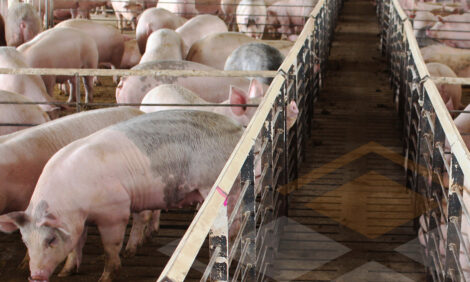
Ron Plain
|
USDA’s September Hogs and Pigs report said the nation’s swine inventory is smaller than a year ago, but it is not as small as the average of the pre-release trade estimates. According to USDA’s latest survey, the breeding herd was down 2.8% on September 1, the market herd was down 1.7%, and the total swine inventory was 1.8% smaller than one year earlier. The difference between USDA’s numbers and industry forecasts, including ours, is not big enough to cause us to doubt the accuracy of the report.
This report is clearly not what hog producers were hoping for. The average farrow-to-finish producer has earned a profit in only 3 of the last 22 months. We are at that point in the hog cycle when inventories are supposed to be well below year-ago levels and declining. Instead, this report paints a picture of an industry about to push production back up to year-ago levels. That conclusion is consistent with sow and gilt slaughter data, both of which have been below year-ago levels in recent weeks.
USDA said the inventory of market hogs weighing 180 pounds or more on September 1 was 4.7% smaller than a year ago. Daily hog slaughter during September appears to be down a bit over 4% from September 2002. This higher-than-implied slaughter can be readily explained by the increase in the number of slaughter hogs believed imported from Canada in recent weeks.
The number of market hogs weighing 120 to 179 pounds on September 1 was down 1.6% from last year and the number weighing 60 to 119 pounds was down 0.6%. The inventory in each category appears high given that USDA also said the March-May pig crop was 3.5% smaller than in 2002. Imports are a major factor in explaining this discrepancy. April feeder pig imports were up 89,193 head compared 2002. May feeder pig imports were up 73,392 head compared to May 2002. Obviously, increased pig imports drives up the market hog inventory without the need of a larger U.S. pig crop. Year-to-year differences in growth rates and death loss could also impact on the numbers.
The inventory of pigs weighing less than 60 pounds was down 1.0% on September 1. At first, this appears inconsistent with the June-August pig crop, which was down 2.1%. Once again, imports of Canadian feeder pigs during recent weeks have been heavy enough to explain the entire discrepancy.
The inventory of hogs weighing 60-179 pounds on the first of September (99% of year ago) implies that fourth quarter hog slaughter will be 1% below year-ago levels. However, over the last 12 weeks, we have imported an average of nearly 22,000 more slaughter hogs per week than during the same period last year. If this pace of hog imports continues, then fourth quarter slaughter will be even with or slightly higher than the fourth quarter of 2002. Hog slaughter weights were quite low during the second half of 2002. Carcass weights are likely to average 1-2 pounds heavier this fall than last. Thus, fourth quarter pork production could well be above that of last year if USDA’s market hog inventory is accurate.
The inventory of pigs weighing less than 60 pounds (99% of year ago) implies that first quarter 2004 slaughter will be down 1% compared to the first quarter of this year. Again, what happens with hog imports will influence the final outcome. Canada’s most recent survey implies that their 2003 pig crop will be 2.5-3% larger than last year. Thus, they clearly have the potential to continue sending hogs south at a faster pace than last year.
Although the breeding herd is estimated to be 2.8% smaller than a year ago (and the smallest in well over a century), USDA said the number of sows that farrowed in the last three months was down only 2.1% and future farrowings will be close to year-ago levels. This report forecast September-November farrowings at 2.801 million litters, 0.6% fewer than last fall. This number is 7,000 higher (0.25%) higher than the forecast for the same quarter made in the June Hogs and Pigs Report. December-February farrowings are predicted to total 2.766 million litters, only 1,000 fewer than this past winter.
Pigs per litter during the last 12 months averaged 0.41% higher than during the previous 12 months. If USDA’s farrowing intentions are right and pigs per litter continue to increase at this pace in coming months, then the fall pig crop will be down only 0.2% and the winter pig crop will be up 0.4% compared to a year ago. Assuming a continuing increase in live imports from Canada, we should see spring 2004 hog slaughter above that of this past spring, and summer slaughter 1-2% larger than the summer of 2003. If USDA’s farrowing intentions are close to the mark, then we are very likely to slaughter more hogs in 2004 than in 2003.
Lean hog futures contracts have indicated producers would face only modest losses this winter and would have a good chance to sell hogs at profitable prices through most of 2004. We are not nearly so optimistic.
Not all of the outlook news about next year is negative. The supply of competing meats is expected to be down in 2004. USDA is forecasting red meat and poultry production next year will be 672 million pounds (0.8%) lower than in 2003 due to an expected 1.119 billion pound drop in beef production. USDA is forecasting that 2004 will be the thirteenth consecutive record year for U.S. pork exports.
The domestic demand for pork has been weak thus far in 2003. Based on preliminary data, January-August domestic pork demand index was down 3% from 2002’s level. This is surprising given the record high price of retail beef. A turn-around in pork demand would go a long way toward making 2004 a profitable year for producers.
Our estimates of slaughter by quarter and live hog prices are in Table 4. One might note that, compared to this year, 2004 has one extra slaughter day during the first quarter and one fewer day during the fourth quarter.
Table 1. Hog Inventories June 1, U.S.
______________________________________________________________
2003 as % of 2002
Market 98
Kept for breeding 97
All hogs and pigs 98
______________________________________________________________
Table 2. Market Hogs on Farms June 1, U.S.
_____________________________________________________________
Weight Category 2003 as % of 2002
Under 60 pounds 99
60 - 119 pounds 99
120 - 179 pounds 98
180 pounds and over 95
_____________________________________________________________
Table 3. Sows Farrowing and Intentions, U.S.
_____________________________________________________________
2003 as % of 2002
March-May 96
June-August 98
September-November 99
2004 as % 9f 2003
December-February 100
______________________________________________________________
Table 4. Estimated Commercial Hog Slaughter by Quarter and
Live Hog Prices 1998-2004
____________________________________________________________________
Commercial Terminal Market 51-52% Lean
Slaughter Barrows & Gilts Hogs
Period (mil. hd.) (price/cwt.) (price/cwt.)
____________________________________________________________________
1998 1 24.776 $34.74
2 23.628 39.42
3 25.039 33.62
4 27.586 19.49
Year 101.029 31.82
1999 1 25.579 $26.55 $28.83
2 24.288 33.06 35.18
3 24.953 32.78 35.70
4 26.724 33.88 36.29
Year 101.544 31.57 34.01
2000 1 25.039 $39.11 $41.14
2 23.125 47.99 50.43
3 24.097 44.19 46.44
4 25.715 38.33 40.78
Year 97.976 42.41 44.70
2001 1 24.578 $40.77 $42.83
2 23.280 50.21 52.05
3 23.635 48.04 51.05
4 26.469 34.97 37.30
Year 97.962 43.50 45.81
2002 1 24.148 $37.23 $39.43
2 24.280 32.77 34.99
3 25.120 31.09 33.86
4 26.715 28.52 31.34
Year 100.263 32.40 34.91
2003 1 24.620 $33.32 $35.38
2 23.890 39.86 42.64
3 (projected) 24.710 38 - 39 42 - 43
4 (projected) 26.540 33 - 36 36 - 39
Year (proj.) 99.760 36 - 37 39 - 41
2004 1 (projected) 24.870 $35 - 38 $38 - 41
3 (projected) 25.030 37 - 40 40 - 43
2 (projected) 24.160 38 - 41 41 - 44
4 (projected) 26.520 32 - 35 35 - 38
Year (proj.) 100.580 35 - 38 38 - 41
____________________________________________________________________
|
Graph Data from the Report
US Quarterly Litter Rate
June - August

US Pigs Per Litter
By Size of Operation: June - August 2003

US Quarterly Sows Farrowed
June - August

US Quarterly Pig Crop
June - August

March 1 - Hog Inventory and Market Hogs (US)

June 1 - Hog Inventory and Market Hogs (US)

September 1 Hog Inventory and Market Hogs (US)

December 1 Hog Inventory and Market Hogs (US)

Reliability of June 1 Hogs and Pigs Estimates
Survey Procedures: A random sample of roughly 12,200 U.S. producers was surveyed to provide data for these estimates. Survey procedures ensured that all hog and pig producers, regardless of size, had a chance to be included in the survey. Large producers were sampled more heavily than small operations. Data were collected from about 9,900 operations, 82 percent of the total sample, during the first-half of September by mail, telephone, and face-to-face personal interviews. Regardless of when operations responded, they were asked to report inventories as of September 1.
Estimation Procedures: These hogs and pigs estimates were prepared by the Agricultural Statistics Board after reviewing recommendations and analysis submitted by each State office. National and State survey data were reviewed for reasonableness with each other and with estimates from past years using a balance sheet. The balance sheet begins with the previous inventory estimate, adds the estimates of births and imports, and subtracts the estimates of slaughter, exports, and deaths. This indicated ending inventory level is compared to the Agricultural Statistics Board estimate for reasonableness.
Revision Policy: Revisions to previous estimates are made to improve quarter to quarter relationships. Estimates for the previous four quarters are subject to revision when current estimates are made. In December, estimates for all quarters of the current and previous year are reviewed. The reviews are primarily based on hog check-off receipts and slaughter. Estimates will also be reviewed after data from the Department of Agriculture five-year Census of Agriculture are available. No revisions will be made after that date.
Reliability: Since all operations raising hogs are not included in the sample, survey estimates are subject to sampling variability. Survey results are also subject to non-sampling errors such as omissions, duplication, and mistakes in reporting, recording, and processing the data. The affects of these errors cannot be measured directly. They are minimized through rigid quality controls in the data collection process and through a careful review of all reported data for consistency and reasonableness.
To assist users in evaluating the reliability of the estimates in this report, the "Root Mean Square Error" is shown for selected items in the following table. The "Root Mean Square Error" is a statistical measure based on past performance and is computed using the difference between first and final estimates. The "Root Mean Square Error" for hog inventory estimates over the past 20 quarters is 1.0 percent. This means that chances are 2 out of 3 that the final estimate will not be above or below the current estimate of 59.6 million head by more than 1.0 percent. Chances are 9 out of 10 that the difference will not exceed 1.7 percent.
Source: Quarterly Hogs and Pigs Report, September 2003 - USDA National Agricultural Statistics Service |




















